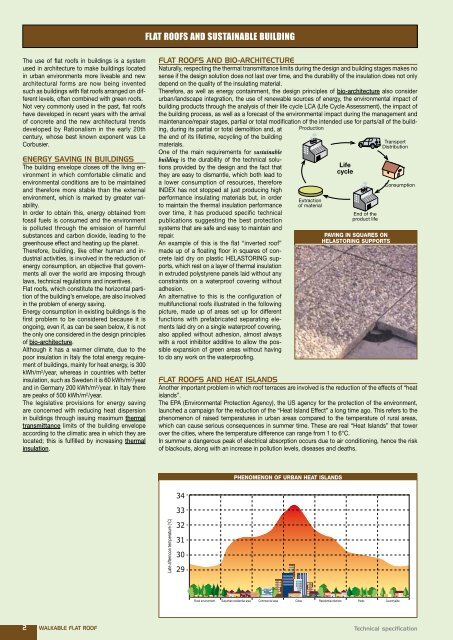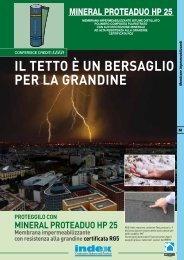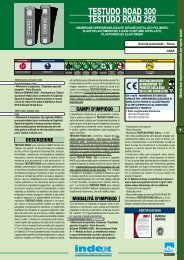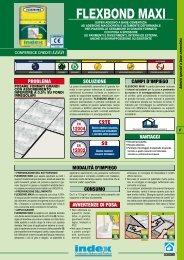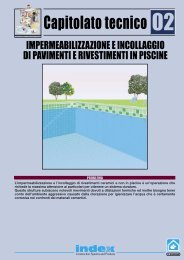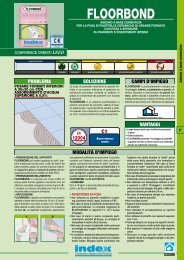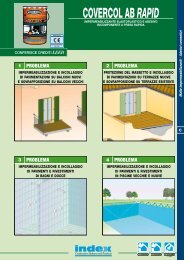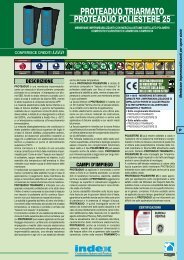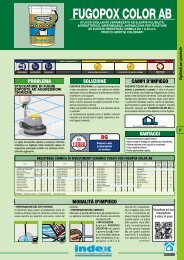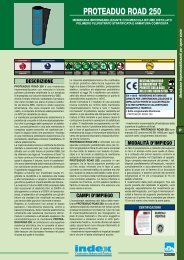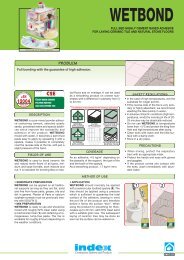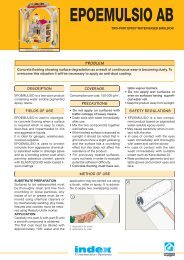Technical specification - Index S.p.A.
Technical specification - Index S.p.A.
Technical specification - Index S.p.A.
You also want an ePaper? Increase the reach of your titles
YUMPU automatically turns print PDFs into web optimized ePapers that Google loves.
FLAT ROOFS AND SUSTAINABLE BUILDING<br />
The use of flat roofs in buildings is a system<br />
used in architecture to make buildings located<br />
in urban environments more liveable and new<br />
architectural forms are now being invented<br />
such as buildings with flat roofs arranged on different<br />
levels, often combined with green roofs.<br />
Not very commonly used in the past, flat roofs<br />
have developed in recent years with the arrival<br />
of concrete and the new architectural trends<br />
developed by Rationalism in the early 20th<br />
century, whose best known exponent was Le<br />
Corbusier.<br />
ENERGY SAVING IN BUILDINGS<br />
The building envelope closes off the living environment<br />
in which comfortable climatic and<br />
environmental conditions are to be maintained<br />
and therefore more stable than the external<br />
environment, which is marked by greater variability.<br />
In order to obtain this, energy obtained from<br />
fossil fuels is consumed and the environment<br />
is polluted through the emission of harmful<br />
substances and carbon dioxide, leading to the<br />
greenhouse effect and heating up the planet.<br />
Therefore, building, like other human and industrial<br />
activities, is involved in the reduction of<br />
energy consumption, an objective that governments<br />
all over the world are imposing through<br />
laws, technical regulations and incentives.<br />
Flat roofs, which constitute the horizontal partition<br />
of the building’s envelope, are also involved<br />
in the problem of energy saving.<br />
Energy consumption in existing buildings is the<br />
first problem to be considered because it is<br />
ongoing, even if, as can be seen below, it is not<br />
the only one considered in the design principles<br />
of bio-architecture.<br />
Although it has a warmer climate, due to the<br />
poor insulation in Italy the total energy requirement<br />
of buildings, mainly for heat energy, is 300<br />
kWh/m 2 /year, whereas in countries with better<br />
insulation, such as Sweden it is 60 kWh/m 2 /year<br />
and in Germany 200 kWh/m 2 /year. In Italy there<br />
are peaks of 500 kWh/m 2 /year.<br />
The legislative provisions for energy saving<br />
are concerned with reducing heat dispersion<br />
in buildings through issuing maximum thermal<br />
transmittance limits of the building envelope<br />
according to the climatic area in which they are<br />
located; this is fulfilled by increasing thermal<br />
insulation.<br />
FLAT ROOFS AND BIO-ARCHITECTURE<br />
Naturally, respecting the thermal transmittance limits during the design and building stages makes no<br />
sense if the design solution does not last over time, and the durability of the insulation does not only<br />
depend on the quality of the insulating material.<br />
Therefore, as well as energy containment, the design principles of bio-architecture also consider<br />
urban/landscape integration, the use of renewable sources of energy, the environmental impact of<br />
building products through the analysis of their life cycle LCA (Life Cycle Assessment), the impact of<br />
the building process, as well as a forecast of the environmental impact during the management and<br />
maintenance/repair stages, partial or total modification of the intended use for parts/all of the building,<br />
during its partial or total demolition and, at<br />
the end of its lifetime, recycling of the building<br />
materials.<br />
One of the main requirements for sustainable<br />
building is the durability of the technical solutions<br />
provided by the design and the fact that<br />
they are easy to dismantle, which both lead to<br />
a lower consumption of resources, therefore<br />
INDEX has not stopped at just producing high<br />
performance insulating materials but, in order<br />
to maintain the thermal insulation performance<br />
over time, it has produced specific technical<br />
publications suggesting the best protection<br />
systems that are safe and easy to maintain and<br />
repair.<br />
An example of this is the flat “inverted roof”<br />
made up of a floating floor in squares of concrete<br />
laid dry on plastic HELASTORING supports,<br />
which rest on a layer of thermal insulation<br />
in extruded polystyrene panels laid without any<br />
constraints on a waterproof covering without<br />
adhesion.<br />
An alternative to this is the configuration of<br />
multifunctional roofs illustrated in the following<br />
picture, made up of areas set up for different<br />
functions with prefabricated separating elements<br />
laid dry on a single waterproof covering,<br />
also applied without adhesion, almost always<br />
with a root inhibitor additive to allow the possible<br />
expansion of green areas without having<br />
to do any work on the waterproofing.<br />
Production<br />
Extraction<br />
of material<br />
Life<br />
cycle<br />
End of the<br />
product life<br />
PAVING IN SQUARES ON<br />
HELASTORING SUPPORTS<br />
Transport<br />
Distribution<br />
Consumption<br />
FLAT ROOFS AND HEAT ISLANDS<br />
Another important problem in which roof terraces are involved is the reduction of the effects of “heat<br />
islands”.<br />
The EPA (Environmental Protection Agency), the US agency for the protection of the environment,<br />
launched a campaign for the reduction of the “Heat Island Effect” a long time ago. This refers to the<br />
phenomenon of raised temperatures in urban areas compared to the temperature of rural areas,<br />
which can cause serious consequences in summer time. These are real “Heat Islands” that tower<br />
over the cities, where the temperature difference can range from 1 to 6°C.<br />
In summer a dangerous peak of electrical absorption occurs due to air conditioning, hence the risk<br />
of blackouts, along with an increase in pollution levels, diseases and deaths.<br />
PHENOMENON OF URBAN HEAT ISLANDS<br />
Late afternoon temperature (°C)<br />
Rural environment Suburban residential area Commercial area Cities Residential districts Parks Countryside<br />
2 WALKABLE FLAT ROOF <strong>Technical</strong> <strong>specification</strong>


